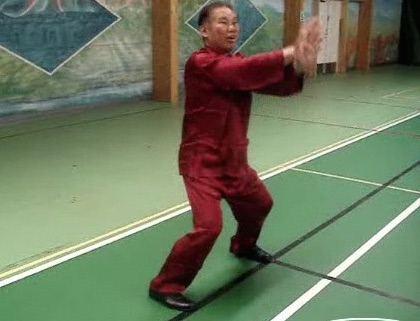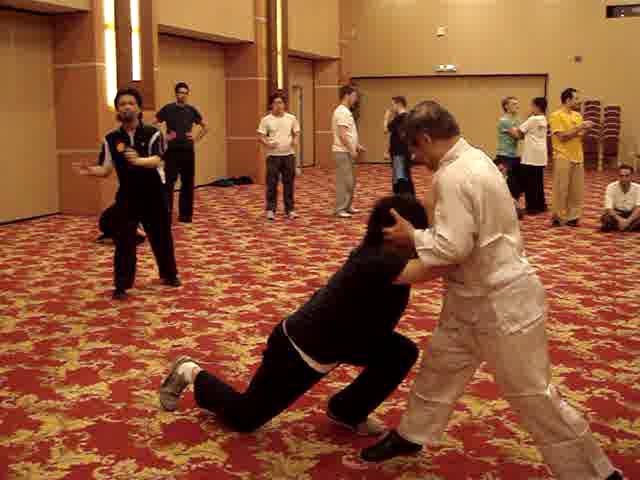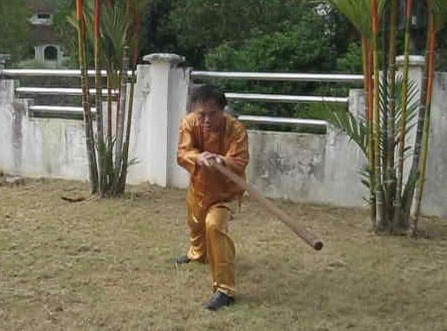PROFUNDITY IN SIMPLICITY OF CHOE FAMILY WING CHOON

Tremendous internal force can be generated from Double Worshiping of the Buddha
Question 10
You have said that the most outstanding lesson that you have learned from Sigung Choe Hoong Choy is "profundity in simplicity". Could you please give some examples of "profundity in simplicity" in Choe family Wing Choon?
Has practicing Choe family Wing Choon given you any "aha" moments that furthered your understanding or allowed for break-throughs in the other styles of Kung Fu you practice?
Chris Swacha
Answer
My sifu, Sifu Choe Hoong Choy, often mentioned the phrase, “Sum yap chean chuit”, which literally means “deep enter, shallow emerge”. Figuratively it means “something looks very profound, but is actually simple once it is explained”. I translate the phrase in a more familiar English expression as “profundity in simplicity”.
There are many examples of profundity in simplicity in Wing Choon Kungfu that many Wing Choon practitioners may not realize. This statement, of course, is never meant to belittle the Wing Choon practitioners involved, but is meant to help them to improve their art if they are humble enough to listen. It is also no surprise that many Wing Choon practitioners may not realize the profundity of their art because this profundity is explained in secrets normally kept only for selected disciples.
To be comprehensive in my explanation, I shall use examples from each of the four dimensions of kungfu, namely form, force, application and philosophy.
This concept of four dimensions in kungfu is itself a profundity. Not many kungfu practitioners look at their art in this way; they only learn more and more techniques but have no idea of the kind of force particular to their art, do not know how to apply their techniques for combat, and have no idea of its philosophy.
This four-dimension concept was not taught to me by Sifu Choe Hoong Choy. I developed this concept when I wrote my first kungfu book, Introduction to Shaolin Kungfu, in the late 1970s. But Sifu Choe Hoong Choy's explanation of the profundity of Wing Choon Kungfu touched on all these four dimensions.
Wing Choon form is meant for the small size against bigger and stronger opponents. If all other things were equal, it would be difficult for a Wing Choon practitioner when an opponent employs chin-na or gripping attack on him. Taking Siu Lin Tou to be typical of Wing Choon form, to many Wing Choon practitioners there don't seem to be many counters against chin-na! In fact I suspect many Wing Choon practitioners would be in trouble if tiger-claw or eagle-claw exponents grip their arms. Chin-na is the nemesis of Wing Choon Kungfu.
How did Wing Choon masters in the past counter chin-na attacks? Although many Wing Choon practitioners today may not know of the counters, past Wing Choon masters must have countered chin-na successfully, otherwise Wing Choon Kungfu would have been eliminated. This was natural selection. If any martial art was inadequate, it would have been eliminated by natural selection in fighting as a matter of course.
If this was so, then why many Wing Choon practitioners today do not know counters against chin-na, yet Wing Choon Kungfu continues to prosper. The reason is that not many martial artists know how to apply chin-na techniques successfully. Today, if you are prepared to sustain injuries yourself, you just rush in to rain blows on your opponents, you would be considered a formidable fighter! If someone did that in the past, he would be killed instantly.
Wing Choon Kungfu has very effective counters against chin-na, its nemesis. This was a hallmark of a great kungfu style, i.e. not only the Wing Choon masters understood the innate weakness of the art, they could turn the table round on their opponents should the opponents attempt to exploit the innate weakness. Herein lies the profundity in simplicity of Wing Choon Kungfu.

Not many Wing Choon practitioners realize that there are many chin-na techniques in Wing Choon Kungfu
Where are the Wing Choon counters against chin-na? They are found at the end of every sequence in Siu Lin Tou! Yim Wing Choon knew the innate weakness of her art very well, so she incorporated effective counters at every sequence so that she had sufficient practice.
If you grip the wrist of a Wing Choon master, he will circulate his hand to release the grip, and thrust his fingers into your throat. If you grip his wrist with one hand, and his elbow with another, he will use covering hand to release your grip, and thrust a phoenix-eye fist into your solar plexus.
Many martial artists may say, “Well, these two counters may be effective, but they are just two counters against countless other chin-na attacks. What happens if opponents use other chin-na techniques?”
Here is where “sam yap chean chuit”, or “profundity in simplicity”, comes in. There are countless ways of gripping in chin-na, but all the grips may be divided into two main categories, single-hand grips and double-hand grips.
The first grip mentioned above is an example of a single-hand grip, and the second grip is that of a double-hand grip. Although there are countless ways of chin-na, by applying the principle of “sam yap chen chuit”, we can use the same two principles to counter any chin-na attack!
The second dimension where we can examine “sam yap chean chuit” is skill. Wing Choon Kungfu is known for its skill of “inch-force”, where you can injure an opponent within inches. This is a very useful skill for Wing Choon Kungfu where economy of movement is crucial, unlike in external martial arts where exponents need distance to develop momentum for their striking impact.
To many people, even the concept of “inch force” is unbelievable. How could you damage an opponent from just inches away? Their problem arises because they think that damage is only possible with muscular strength, and in muscular strength it is necessary to pick up momentum. But this problem does not arise in internal force.
In Wing Choon Kungfu, internal force is developed by practicing Siu Lin Tou -- if practitioners know how, and many practitioners do not know how. My glimpse of “sam yap chean chuit” in this respect was when my sifu, Sifu Choe Hoong Choy, showed me his performance of Siu Lin Tou in slow motion in a relaxed manner, thus enabling energy to flow.
This flowing energy is consolidated into internal force when used to strike an opponent within inches. Consolidating force is attained using the triple-stretch method, which is also found in Siu Lin Tou. But many Wing Choon practitioners today do not know this triple-stretch method. They perform Siu Lin Tou as isometric exercise, developing muscles instead of internal force.
Muscular strength is powerful, but it is not internal force. Muscular strength needs momentum to general power, unlike inch-force. More significant in daily life, energy is locked up in the muscles, which is detrimental to health.
Understanding this philosophy of internal force in Wing Choon Kungfu is very useful, but more important is to put it into practice in combat as well as in daily life, resulting in “sam yap chean chuit”, or profundity in simplicity.
The third dimension is application. There are countless aspects of combat application, but we can sum up these countless aspects into one main aspect, i.e. how is Wing Choon Kungfu used by a small-sized exponent against bigger, stronger opponents. Like in Taijiquan, there are two reasons -- internal force and mechanics.
If you have a lot of internal force, you can defeat opponents irrespective of their age, size and gender. If you use appropriate mechanics, you can beat opponents bigger and stronger than you. Of course, your task is easier when you have both internal force and appropriate mechanics.
As we have discussed internal force, we shall now focus on mechanics in Wing Choon Kungfu.
As in Taijiquan though the finer movements are different, the core of Wing Choon mechanics is in the waist. Those who insist on keeping the center-line, thus maintaining their frontal position, would have missed much of the advantage of waist rotation in Wing Choon mechanics.
A lot of my Wing Choon movements today involve waist rotation as it gives me many advantages. I cannot remember exactly whether that was what I originally learned from Sifu Choe Hoong Choy or it was my later innovation, but my Taijiquan practice has certainly much influenced it.
For example, suppose I am facing north, and an opponent is thrusting a cup fist into my solar plexus. Instead of maintaining my body facing north and moving my left palm from left to right to deflect the coming cup fist, like what many Wing Choon practitioners would do, I would rotate my waist slightly as I deflect the attack with my left palm so that my body would end facing north-east instead of still facing north. In this way I use less force to attain the same result as my deflection comes from the rotation of my waist. In the other example, the deflection comes from the left shoulder.

Rotating the waist minimize an opponent's force
It is pertinent to mention that this pattern, “pak sau” or “slap hand”, is performed in Siu Lin Tou without waist rotation. But in other kungfu sets in Choe Family Wing Choon, like in the Flower Set, “pak sau” is performed with waist rotation. My conclusion is that the focus of Siu Lin Tou is to develop internal force, including in “pak sau”, so keeping the body in a frontal position is desirable, whereas in the Flower Set, the focus of the same pattern is combat application, so rotating the waist is advantageous.
Those who have learnt the principle of “sam yap chean chuit” will understand the profundity of applying this simple principle in a great variety of combat applications. Those who have not learnt this principle, or whose training is limited to only Siu Lin Tou, would have missed this opportunity.
In other patterns in Siu Lin Tou, waist rotation is used. In “bong sau” or “guard-hand”, for example, it is waist rotation, and not the strength of the defending arm, that deflects an opponent’s attack. In “lap-sau” or “pull-hand”, found in the Cham Kiew section of Siu Lin Tou of Choe Family Wing Choon, it is waist rotation in conjunction with footwork that pulls an opponent to fall forward, not the pulling strength from the shoulders. All these examples manifest the principle of “sam yap chean chuit” or profundity in simplicity of the application dimension of Wing Choon Kungfu.
We shall now examine profundity in simplicity under the fourth dimension of any kungfu, i.e. philosophy. There are many different ways of addressing this philosophical dimension in relation to profundity in simplicity, but we shall address it to a very important question, though not many people actually ask themselves this question. Why do we practice Wing Choon Kungfu?
Our answer is to enrich our life. In more particular terms, it is to give us good health, vitality, longevity, combat efficiency, mental clarity, and spiritual joys. In other words, by practicing Wing Choon Kungfu, we aim to be free from pain and illness, to enjoy our daily work and play, to live to a ripe old age, to use Wing Choon skills and techniques to defend ourselves when needed, to be stressfree and be able to think well, and to be relaxed, peaceful and happy.
So, if you habitually exchange blows with your classmates in free sparring, you are not free from pain and illness, and are also unable to defend yourselves. If you are often tensed, angry or nervous, you have not attained spiritual joys. In other words, you have not achieved your aim of practicing Wing Choon Kungfu.
There is much profundity in the aim we have set for practicing Wing Choon Kungfu, or any style of kungfu. Yet, to attain the aim is quite simple, i.e. practice it correctly. This is a manifestation of profundity in simplicity.
Yes, practicing Choe Family Wing Choon has given me many “aha” moments. One outstanding example happened just a few years ago, i.e. many years after I learned from Sifu Choe Hoong Choy.
I was lying in bed one night on the Blue Mountain. While teaching there, I was also preparing myself to teach a Special Wing Choon Course in Penang a few months later. I was thinking of the pattern, “Seong Pai Fatt” or “Double Worshiping of the Buddha”, at the start of Siu Lin Tou, and recalled reading that it was a very powerful pattern. I jumped out of bed and performed a few patterns of “Double Worshipping of the Buddha” in total darkness. I was surprised to hear and feel some thunderous sounds, “boom boom boom”, bouncing off from a wall. I decided to stop, least Rama, the owner of the Blue Mountain, thought an earthquake had happened. “Aha!” I suddenly realized why Ng Mui, the teacher of Yim Wing Choon, was so powerful despite her age and slender figure.
Another “aha” experience I still remember was when my sifu, Sifu Choe Hoong Choy, demonstrated to me a combat application of “thap choui” or “hammer-fist”. Although it was called “hammer-fist”, the pattern was a thrusting out of a phoenix-eye fist at an opponent’s solar plexus.
Just seeing the application once enabled me to realize why the pattern was called “thap-choui”. It opened up for me a whole range of combat applications, manifesting a hallmark of Wing Choon Kungfu, i.e. striking down an opponent as soon as he moves!
It is very effective, but also very vicious. It shows no mercy, killing or maiming an opponent in just one move. It may not be practical in today’s law-abiding society, where the Taijiquan techniques of pushing away opponents, or the more drastic but still very compassionate Shaolin chin-na would be more appropriate. But if a situation warrant its, like in a life-death challenge match, this technique, of course with the necessary skill, can fell an opponent, regardless of his size and strength, in just one move. This is Wing Choon Kungfu. It is not raining a series of chain-punches on an opponent and he still can fight.
Another “aha’ experience occurred during a session when Sifu Choe Hoong Choy taught me the Six-and-Half-Point Staff. I do not mean to be presumptuous and I mentioned this in good faith, all of a sudden all the other fighting techniques using weapons, especially those I saw in movies, appeared third-class. By comparison the techniques of Six-and-Half-Point Staff were so direct and effective. I was already good with weapons after learning the Flowing Water Staff from Sifu Ho Fatt Nam. The Six-and-Half-Pint Staff enhanced my combat efficiency further.
These “aha” experiences from Choe Family Wing Choon furthered my understanding and contributed to break-throughs in the other kungfu styles I practice.
“Thap-choui”, for example, enhanced my understanding and application of Shaolin tiger-claw and Taijiquan single-whip. Previously, I could use “Fierce Tiger Descends Mountain” as a defence move, and “Single Whip” as an attack. With better understanding, I can now incorporate attack in “Fierce Tiger Descends Mountain” and incorporate defence in “Single Whip”, applying them as “defence-cum-counter” and later as “no-defence-direct-counter”.
These ‘aha’ experiences also enrich my chi kung teaching and healing. The realization that chi flow, which was a manifestation of profundity in simplicity, is necessary in developing internal force like in Siu Lin Tou, later contributed to my understanding it was chi flow, and not the exercise itself, that relieved patients of their pain and illness. It might not be the only contributing factor, but certainly it added to the contribution to later break-throughs, which eventually led to the development of our chi kung healing to such a high level that it could be employed to overcome any disease! This development also illustrates the importance of breadth and depth.
The break-throughs due to the realization of chi flow occur not just in kungfu and chi kung but also in our daily life. Many people have kindly expressed their amazement at my quick and coherent way of thinking. In a Zen course in Zurich, for example, I could give an impromptu talk immediately after being given a topic. I could do so because I let my mind flow, which was a logical development of chi flow.
Many profound attainments in Wing Choon Kungfu are actually simple when we know their philosophy and practice. This was what Sifu Choe Hoong Choy often said, “sam yap chean chuit”, or “deep enter shallow emerge”. A taste of such profundity in simplicity will be found in the coming Wing Choon course in Barcelona.

The techniques in the Six-and-Half-Point Staff of Wing Choon Kungfu are profundity in simplicity
The questions and answers are reproduced from the thread Wing Choon Kungfu -- 10 Questions to Grandmaster Wong in the Shaolin Wahnam Discussion Forum.
LINKS
